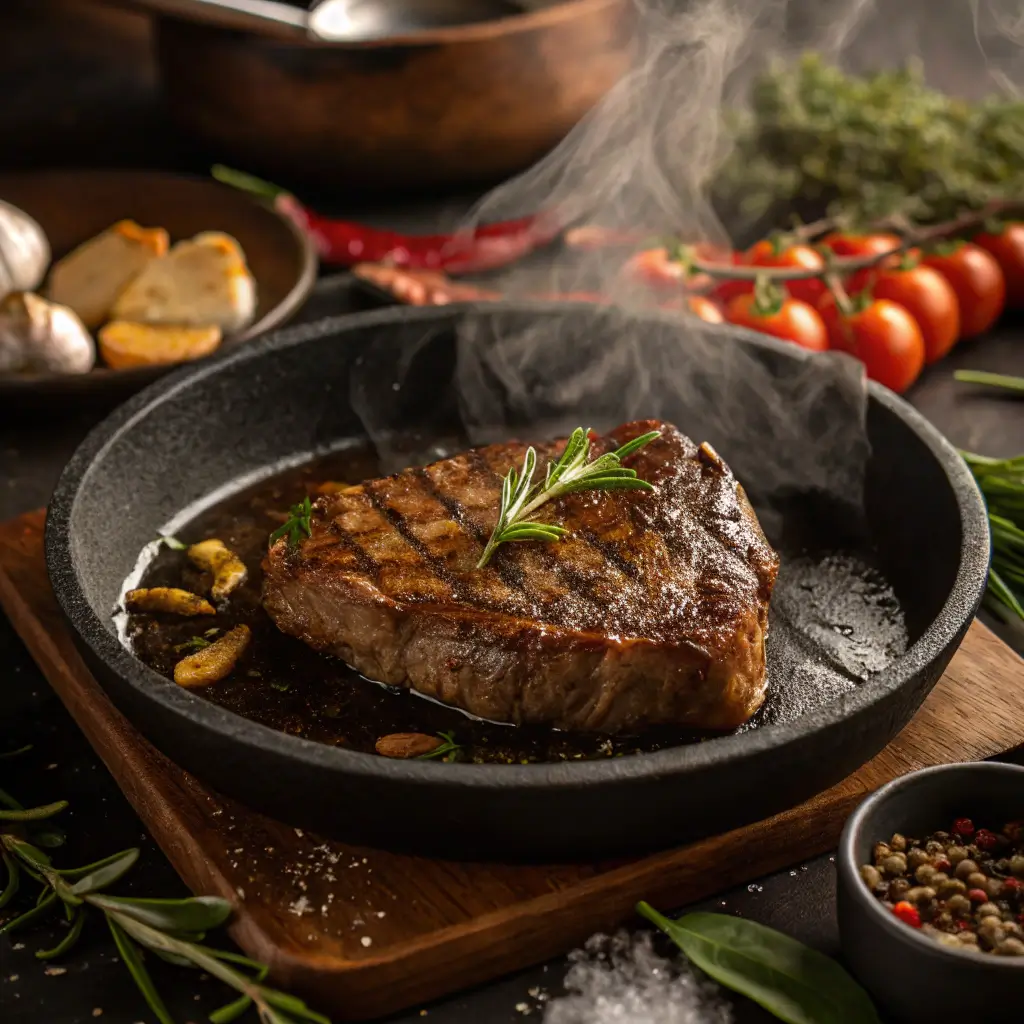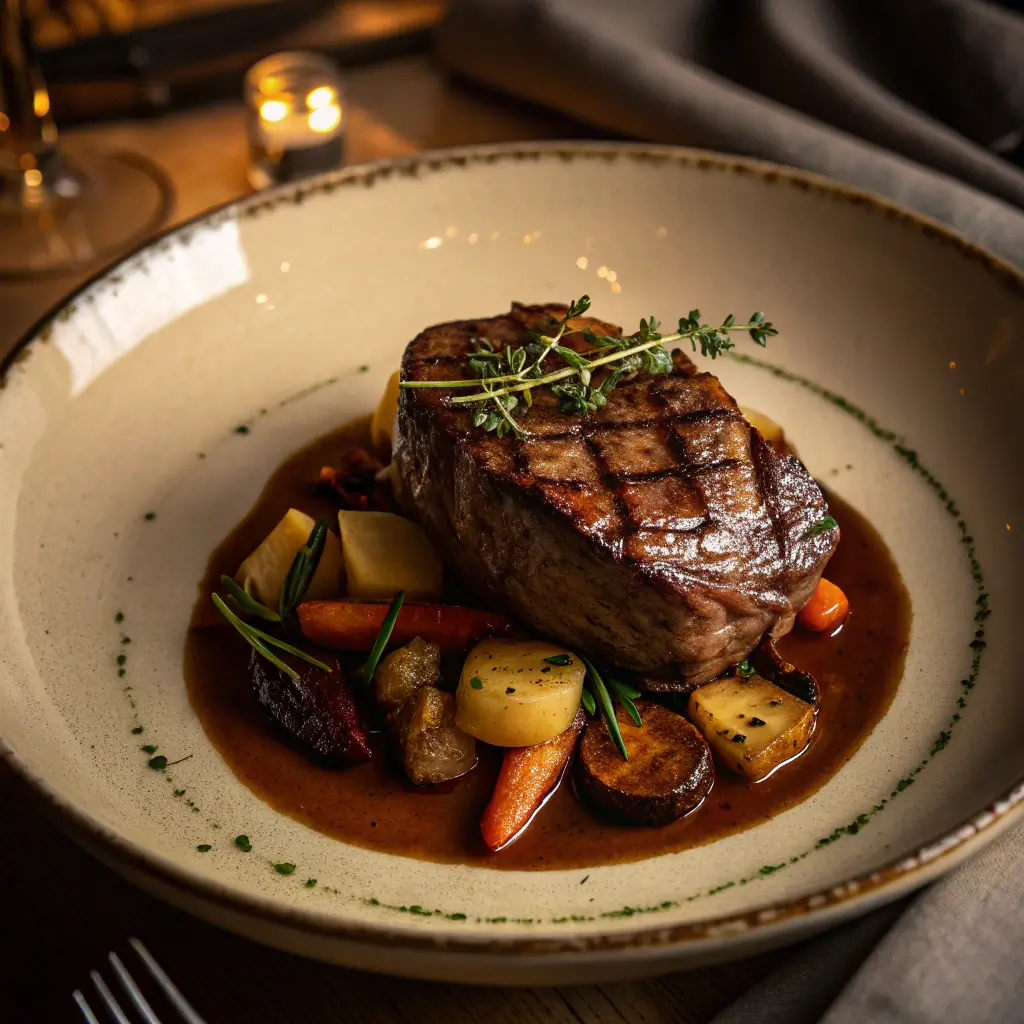Gordon Ramsay’s Perfect Steak Recipe
Introduction
When it comes to cooking steak, few names carry the same weight as Gordon Ramsay. Known for his precision, passion, and dedication to culinary excellence, Ramsay has elevated the art of steak cooking into something unforgettable. His method for preparing the perfect steak is simple, foolproof, and focused on one principle: let the meat shine.
Whether you’re using a ribeye, filet mignon, New York strip, or sirloin, Gordon Ramsay’s technique ensures a juicy, tender, flavorful steak every time. The beauty of this recipe lies in its simplicity—high-quality beef, careful seasoning, precise heat control, and just the right finishing touches. With a little practice, you’ll be able to replicate restaurant-level steak in your own kitchen.

Why This Steak Recipe Works
- Simplicity: No complicated marinades—just salt, pepper, butter, garlic, and herbs.
- Golden Crust: Achieved by searing in a hot pan for that perfect caramelization.
- Juicy Interior: Resting the steak ensures the juices redistribute for maximum flavor.
- Versatility: Works with different cuts of steak and pairs with endless side dishes.
- Foolproof Method: Ramsay’s approach is straightforward enough for beginners, yet refined enough for pros.
Ingredients
For 2 servings:
- 2 steaks (ribeye, New York strip, filet mignon, or sirloin, 1–1½ inches thick)
- 2 tablespoons olive oil (or vegetable oil with a high smoke point)
- 2–3 tablespoons unsalted butter
- 3–4 garlic cloves, lightly crushed (leave the skins on)
- 2–3 sprigs fresh thyme (or rosemary)
- Salt, to taste
- Freshly cracked black pepper, to taste
Step-by-Step Instructions
Step 1: Preparing the Steak
- Remove the steaks from the refrigerator at least 30 minutes before cooking. This allows them to come to room temperature, ensuring even cooking.
- Pat dry with paper towels to remove excess moisture—this is essential for a good sear.
- Generously season both sides with salt and freshly cracked black pepper. Ramsay emphasizes not being shy with seasoning, as it forms the base of flavor.
Step 2: Heat the Pan
- Place a heavy-bottomed skillet (cast iron is ideal) over high heat.
- Add olive oil and heat until shimmering but not smoking. The pan should be extremely hot before adding the steak.
Step 3: Sear the Steak
- Carefully place the steak in the hot pan, laying it away from you to avoid splatter.
- Press down gently with tongs to ensure full contact with the pan.
- Sear for about 2–3 minutes on the first side without moving it—this helps create a golden-brown crust.
- Flip the steak and sear the other side for another 2–3 minutes.
Step 4: Add Flavor Boosters
- Reduce the heat slightly to medium-high.
- Add butter, crushed garlic cloves, and thyme sprigs to the pan.
- Tilt the pan slightly and use a spoon to continuously baste the steak with the melted, herb-infused butter. This step enhances flavor and keeps the meat juicy.
Step 5: Check for Doneness
Cooking time will vary depending on the thickness of the steak and your preferred doneness:
- Rare: 120°F (about 2 minutes per side)
- Medium Rare: 130°F (3–4 minutes per side)
- Medium: 140°F (4–5 minutes per side)
- Mediumm Well: 150°F (5–6 minutes per side)
- Well Done: 160°F+ (6–7 minutes per side)
Use a meat thermometer for accuracy, or the finger test: gently press the steak with your fingertip; the firmness will resemble different parts of your palm depending on doneness.
Step 6: Rest the Steak
- Once cooked to your liking, remove the steak from the pan and transfer to a cutting board.
- Tent loosely with foil and let it rest for 5–10 minutes.
- Resting allows the juices to redistribute, ensuring each bite is tender and flavorful.
Step 7: Slice and Serve
- Slice against the grain for maximum tenderness.
- Drizzle with the pan juices and garnish with extra thyme if desired.
- Serve with your favorite sides.
Serving Suggestions
A steak as rich and flavorful as this deserves sides that complement without overpowering it. Some great pairings include:
- Classic mashed potatoes with garlic butter
- Roasted or sautéed vegetables like asparagus, mushrooms, or Brussels sprouts
- Crispy French fries or potato wedges
- Creamed spinach for a steakhouse vibe
- Simple green salad with a light vinaigrette
For a lighter option, pair the steak with a quinoa or couscous salad, or even grilled zucchini ribbons.
Tips for Success
- Use a heavy pan: Cast iron retains heat best for a great sear.
- Don’t overcrowd: Cook one or two steaks at a time to avoid steaming.
- Let it rest: Skipping the resting step can cause juices to run out, leaving the steak dry.
- Adjust seasoning: Salt enhances the natural flavors—season liberally before cooking.
- Choose the right cut: Ribeye for richness, filet for tenderness, New York strip for balance.
Variations
- Peppercorn Crust: Coat with cracked peppercorns before searing for extra bite.
- Garlic Butter Finish: Whip softened butter with roasted garlic and herbs, then melt over the hot steak before serving.
- Asian-Inspired: Swap thyme for ginger and scallions, and add a drizzle of soy sauce at the end.
- Spicy Kick: Add chili flakes or sliced fresh chili to the butter while basting.
Make-Ahead & Storage
- Prep ahead: Season steaks up to 12 hours in advance and refrigerate, uncovered, to dry-brine.
- Refrigerate leftovers: Store cooked steak in an airtight container for up to 3 days.
- Reheat gently: Warm in a skillet over low heat with a splash of broth or butter to avoid drying out.
- Freeze option: Cooked steak can be frozen for up to 2 months; thaw overnight before reheating.
Nutrition (Approx. per serving, 6 oz ribeye)
- Calories: 480
- Protein: 38g
- Fat: 36g
- Carbs: 1g
- Fiber: 0g
- Sodium: 480mg

FAQs
What’s Gordon Ramsay’s favorite cut of steak?
He often recommends ribeye for its marbling and flavor, but any premium cut works.
Can I grill instead of pan-searing?
Yes, but Ramsay’s method focuses on pan-searing for a consistent crust and flavor.
Do I need to marinate the steak?
No. High-quality beef only needs seasoning and proper cooking to shine.
How do I get a good crust?
Use a very hot pan, dry steaks, and don’t move them around while searing.
Can I use dried herbs instead of fresh?
Fresh thyme or rosemary is best, but dried herbs can work in a pinch.
Conclusion
Gordon Ramsay’s Perfect Steak Recipe is a masterclass in simplicity and technique. With just a handful of ingredients—salt, pepper, garlic, herbs, and butter—you can transform a good cut of beef into something extraordinary. The key lies in heat control, basting, and patience while resting.
Whether you’re cooking for a weeknight dinner, a date night, or a special occasion, this method guarantees a steakhouse-worthy meal at home. Once you try it, you’ll never look at steak the same way again.
So grab your favorite cut, heat up that skillet, and cook like Ramsay—bold, precise, and always flavorful.
